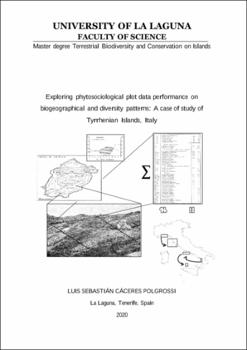Exploring phytosociological plot data performance on biogeographical and diversity patterns: A case of study of Tyrrhenian Islands, Italy.
Fecha
2020Resumen
Islands and archipelagos systems are a test bed for hypotheses on long term evolutionary processes and ecology rules. Both Island Species-Area Relationship (ISAR) and biodiversity are calculated based on flora checklist, but these aren’t always available. Comparing vegetation plot data with flora checklist, it was tested if the first can describe biogeographical patterns through: (1) ISAR model, (2) species diversity and (3) to detect factors influencing islands/archipelago species composition. All vegetation plots available for the Tyrrhenian Sea Islands were assembled. To test (1), ISAR models were calculated by using Arrhenius power function. To test (2), a multiplicative partitioning of beta diversity and a pairwise comparison of beta diversity and its components were calculated for island and archipelago/island-groups identity. To test (3), Non-Metric Multidimensional Scaling (NMDS) was used fitting environmental variables. With these aims, a database with 2544 vegetational plots and 1213 species for 32 islands of the Tyrrhenian Sea islands was created. Flora checklists for 25 islands with a total of 1985 species were obtained. ISAR model based on vegetation plot data detected a significantly higher slope and lower species number per unit area than those based on floristic lists. Observed beta diversity across archipelago/islands-groups was significantly higher than the expected one, and quantitatively higher than the obtained for the islands on both flora and vegetation plot data. Beta diversity among pair resulted that for archipelago/island-groups identity vegetation plot data described turnover and nestedness density curve as good as flora data do. NMDS detect three groups into a strong gradient of temperature, latitude, precipitation and volcanism. ISAR models estimated by vegetation plot data showed bias on c and z parameters estimations, probably due the effect of sampled effort and incompleteness database. Phytosociological data can be used for describing general biogeographical and diversity patterns at macroscale. Tuscan Archipelago is the limit between southern and northern island species composition. Some of theirs islands are the bigger of the whole study system (Elba, M. Argentario, Giglio), with higher altitudes, and moreover, the present of an oceanic island (Capraia) could be one reason of their high nestedness and low turnover.




